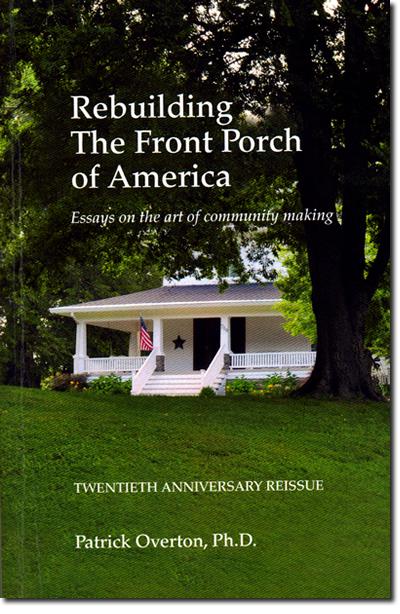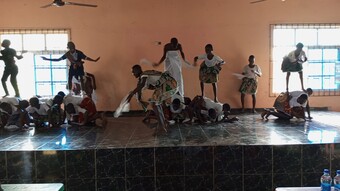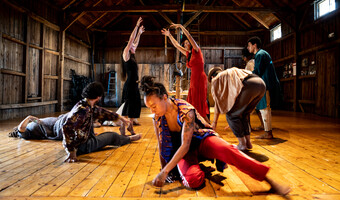Celebrating the New/Old Work of Community Arts Development in Rural/Small Communities in the United States
—“Revitalizing Rural Communities through Arts and Culture”
This quote from an article published by Nancy Duxbury and Heather Campbell in Creative City News in Canada, provides an excellent summary of an international research project in 2009 that focused on the arts in rural/small communities in Europe, Canada, Australia, and the United States. This is one of the most comprehensive studies on the role of the arts in rural/small communities revitalization ever undertaken. This is a wonderful documentation of the ways in which the arts contribute to rural/small communities all around the world.
Looking Back at the Old/New Work
The above assessment of Duxbury and Campbell is consistent with the history of the community arts development field. It is important to know the wide-ranging role the arts have played in the development of rural/small communities for well over two hundred years of the history of this country. As we celebrate the arts in rural/small communities this week, it is appropriate and valuable to acknowledge and embrace this rich history that is uniquely ours. Each one of these movements represents a long tradition, but it is important to remember that when they started, they were brand-new, groundbreaking efforts.
It begins with the earliest citizen self-education/self-development movements of the nineteenth century, the Lyceum (1826) and Lyceum Speakers Bureau (1867). From there, it moves to the Chautauqua (1874), Independent Chautauqua (1878), and, at the turn of the last century, the development of the Tent Chautauqua (1902). All of these various historical movements celebrate the interests and abilities of the citizens of these rural/small communities and changed the lives of many people who lived there.
These historical movements preceded the community arts development movement of the early- to mid-twentieth century. It begins with the development of Civic/Little Theatre/Community Theater movements including Percy MacKaye (Civic Theatre/1912) and Louise Burleigh (The Community Theatre/1917). These efforts were enhanced with the emergence of the strategic combination of University/Community Theater through the groundbreaking work of early community arts development pioneers including Alfred Arvold (The Little Country Theatre/1923), Robert Gard (Grassroots Theater and Arts in Small Communities/1955), and finally, perhaps one of our most important early writers/researchers/practitioners, Baker Brownell (Art Is Action/1939). These early efforts weren’t just efforts to promote the arts, they were specific strategies designed to encourage participation in the arts to generate civic engagement and community self-determination. I am including a Selected Bibliography at the end of this essay to help anyone wishing more information on any of the individuals/movements I have talked about in this historical review.
While many of these arguments have not been tied specifically to rural/small communities, there are useful applications of this material that can be helpful to those who have been working to accomplish these tasks in the rural/small community setting.
Jumping fifty years to the end of the twentieth century and the beginning of the twenty-first century, the focus of much of the arguments for the role of the arts has been centralized on economic development, general community development (quality of life), and the development of social capital. While many of these arguments have not been tied specifically to rural/small communities, there are useful applications of this material that can be helpful to those who have been working to accomplish these tasks in the rural/small community setting.
Americans for the Arts has invested enormous time, energy, and resources in gathering data to support the argument for the important economic impact of the arts and contributions toward a community’s quality of life:
Arts & Economic Prosperity IV demonstrates that America's arts industry is not only resilient in times of economic uncertainty but is also a key component to our nation's economic recovery and future prosperity. Business and elected leaders need not feel that a choice must be made between arts funding and economic prosperity. This study proves that they can choose both. Nationally as well as locally, the arts mean business!
One of the more recent efforts to understand the arts in the community setting emerged in 1999 with the research published by Robert Putnam in his book Bowling Alone. The research data he shared in his book showed a growing national trend toward the decrease of civic engagement. A follow-up project to this publication by Putnam was the Saguaro Seminars (2000), where Putnam gathered a cadre of individuals and explored various ways in which civic engagement is encouraged and enhanced by creating what they called “Social Capital.” The Saguaro Seminar VII narrowed the focus to the role of the arts in promoting social capital through civic engagement. The report from Seminar VII states:
While some still dismiss the arts as nonessential, increasingly they are seen (independent of social capital benefits) as useful in addressing important social issues, such as education, criminal reform, therapy, youth at risk, community healing, job training, etc. Moreover, the arts can provide economic engines for employment, tourism, tax revenues, and revitalizing neighborhoods while fostering pride in community.
Because the arts provide a neutral meeting ground and inherently involve dialogue and cooperation, they are especially conducive to bridging socioeconomic, ethnic, generational, and educational differences. They can function on a deeply personal and emotional level, stripping away the superficial, thus yielding friendships and trust of special intensity. Deeper sharing facilitated by the arts may accelerate the formation of interpersonal bonds faster than would, for example, discussions at a typical Elks meeting.
The final outcome of the Saguaro Seminars was the publication of a report and eventually the book Better Together, published in 2002. This is a significant publication that focuses on important aspects of the arts. While the principles highlighted in this publication are applicable to communities of all size, I believe the findings of the Saguaro Seminars validate the longstanding historical role and value of the arts in rural/small communities—civic engagement and community self-determination. The following quote from this report entitled "Better Together" summarizes this conclusion:
In examining the role of Art and Cultural Institutions, Saguaro outlines principles to transform patrons to participants. Saguaro sees the arts as a tool to help cross-cultural divides, by bringing music, theater, and art to those outside their natural audience. Better Together argues that cultural events must become community institutions and artistic leaders have a strong voice in community planning. The report urges increased government funding for community-based art and recommends artistic productions that address community problems to catalyze civic dialogue.
That was a quick tour through the history and values of the arts in rural/small communities and by no means represents all of the important pioneers and the work they did. What it does do is give a snapshot of three very important conclusions. First, the arts in rural/small communities have been around a long time. Second, this history verifies the important role they play in the social, cultural, educational, and economic life of rural/small communities. And third, these community arts development pioneers highlighted in this essay and the movements they led over the past two hundred years are part of a long, rich heritage and vibrant community-based movement that reflects the important role of the arts in rural/small communities.
Looking Forward to the New/Old Work
While we expand our understanding and contribution of this work in the world in which we live now, we participate in the “New/Old Work” of community arts development begun over two hundred years ago with the Lyceum, Chautauqua, and variety of community arts development movements. And, with the challenges facing our rural/small communities today, it is clear this New/Old Work is more important than ever before.
Is there a common thread that we can identify in all of this material? From my perspective, the answer is yes—it is the understanding that the arts are involved in/related to almost every aspect of life in our rural/small communities. Not art as spectatorship or art as object, but art as something individuals and communities do—something in which people participate and experience on a personal basis. The story of the arts in rural/small communities isn’t about understanding the arts as a noun, something we own. The story is a celebration of the belief that the arts are a verb, an action, something we do.
The genesis for this argument isn’t new. It goes all the way back to one of community arts development’s greatest thinkers and practitioners, Baker Brownell. In 1939, he published a book titled Art Is Action. Quoting from the his introduction:
This book says that art is a natural kind of behavior and that the so-called “fine arts” are more of a burden than they are worth. It says that art is human action—always action, always in action—never the fixed and final structures called works of art. Art from this point of view is action that is immediate in value and at the same time functionally significant in the whole pattern of living.

Essays on the art of Community Making.
Photo by Patrick Overton.
Our challenge is to convince citizens the many ways in which the arts help communities find a way to navigate these challenges.
As we review the emerging and ever-expanding understanding of the role of the arts in rural/small communities, it becomes clear that the arts play an even more important role in rural/small community life than perhaps we have previously understood. But this statement needs to be put against the backdrop of the enormous change and transition facing almost every rural/small community in the United States. Our challenge is to convince citizens the many ways in which the arts help communities find a way to navigate these challenges. I draw many conclusions from what I am seeing as a result of my research for this essay. First, the arts continue to provide citizens in rural/small communities with ways to learn, understand, and reframe the world through self-education and self-improvement. Second, I am convinced the arts help communities celebrate their story and, in many ways, provide an invitation to envision and create a new story. Third, there is growing evidence to support the theory that the arts are a catalyst for community creativity; citizen entrepreneurship; and economic, community, and workforce development and more. And fourth, I agree with Brownell that art is action, providing people in rural/small communities with the opportunity to rehearse citizenship by fulfilling their right to and responsibility for civic engagement and community self-determination. Eventually, I believe our efforts to find and articulate the vital role of the arts in rural/small communities will result in the quintessential argument. It will be indisputable. And, when we do, I believe what happens next will unleash power of this country’s greatest natural resource—our Rural Genius. And we will know that Robert Gard was right, it will indeed “alter the face and the heart of America.”
When I think about this, and I think about it a lot, I am hard pressed to think of any single element or aspect of life in rural/small communities that makes so many different and essential contributions than do the arts. And this puts a smile on my face because I am convinced there is no more exciting a field to be working in right now than doing the New/Old Work of community arts development in rural/small communities.
Selected Bibliography
Arvold, Alfred. The Little Country Theatre. New York: The Macmillian Company, 1923.
Brownell, Baker. Art Is Action. New York: Harper & Brothers Publishers, 1939.
Burleigh, Louise. The Community Theatre. Boston: Little, Brown, and Company, 1917.
Case, V., and Case, R. We Called It Culture: The Story of Chautauqua. Garden City, New York: Doubleday & Company, Inc., 1948.
Gard, Robert E. Grassroots Theatre: A Search for Regional Arts in America. Madison, Wisconsin: The University of Wisconsin, 1955.
Gard, Robert E., and Kolhoff, Ralph. The Arts in the Small Community: A National Plan. Washington, DC: National Assembly of Local Arts Agencies, reprinted 1984.
MacKaye, Percy. The Civic Theatre. New York: Mitchell Kennerley, 1912.
Overton, Patrick. Rebuilding the Front Porch of America: Essays on the Art of Community Making. Astoria: PrairieSea Press, 1997.












Comments
The article is just the start of the conversation—we want to know what you think about this subject, too! HowlRound is a space for knowledge-sharing, and we welcome spirited, thoughtful, and on-topic dialogue. Find our full comments policy here